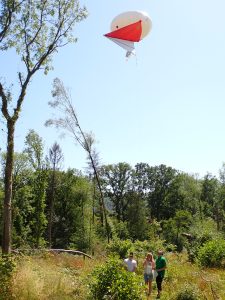Summary
Ips typographus, the eight-toothed spruce bark beetle, is the most serious and destructive pest of spruce trees (Picea spp.) Formerly absent from the UK, a small establishment of Ips typographus was detected for the first time in Kent in 2018. Recent trapping campaigns by Forest Research and the Université libre de Bruxelles provide evidence that the beetle is dispersing hundreds of kilometres from outbreaking European populations, including across the English Channel. However, uncertainty remains around the precise areas of origin of Ips typographus populations in England. Identifying the origin and invasion routes of the beetle is crucial for implementing preventive measures.

A Helikite (pictured above) will be used in France/Belgium as a means of trapping Ips typographus dispersing at high altitudes. A Helikite combines a high-altitude, tethered balloon with a kite, pushed up by both helium and wind. We have attached a lightweight cross vein trap with a pheromone lure to the base of the kite.
Research Objectives
- High-resolution molecular techniques will explore where the various British populations originated, and whether rapid adaptation to a new environment may have facilitated the formation of new establishments.
- To further investigate the hypothesis that Ips typographus is dispersing across the channel, aerial trapping techniques will be implemented to test whether Ips typographus can be caught at various altitudes above the canopy level.
Related research
Larger eight-toothed European spruce bark beetle (Ips typographus) – Forest Research
Evidence of cross-channel dispersal into England of the forest pest Ips typographus
Funding & Partners
-
 DEFRA
DEFRA -
 Université libre de Bruxelles
Université libre de Bruxelles
